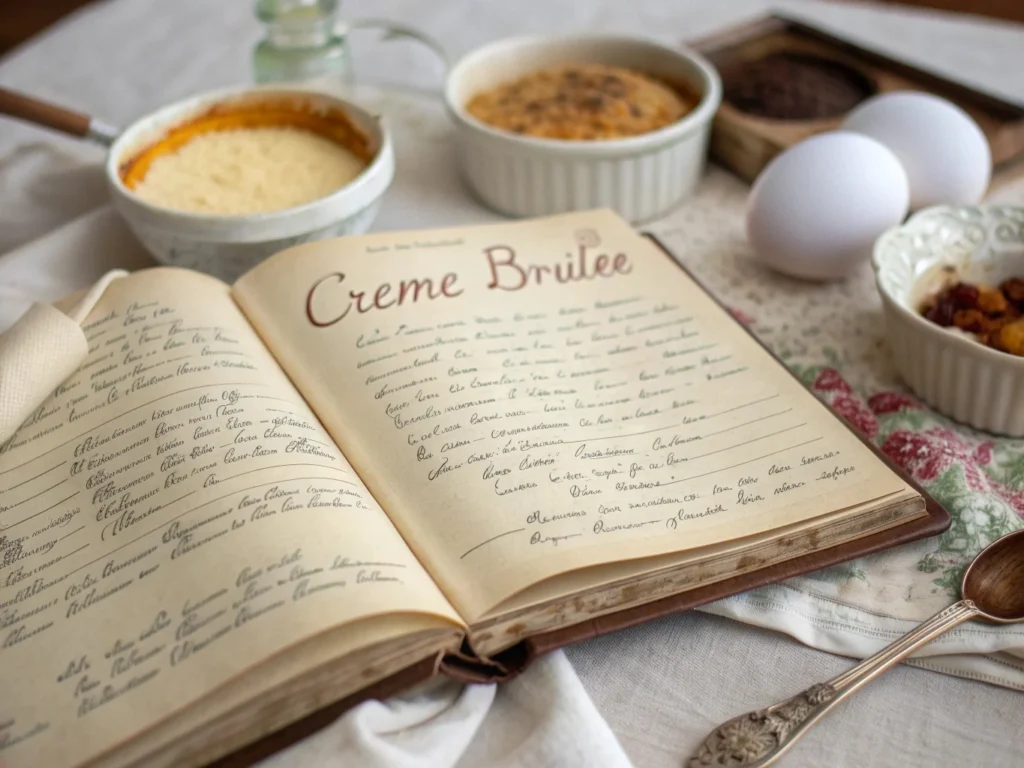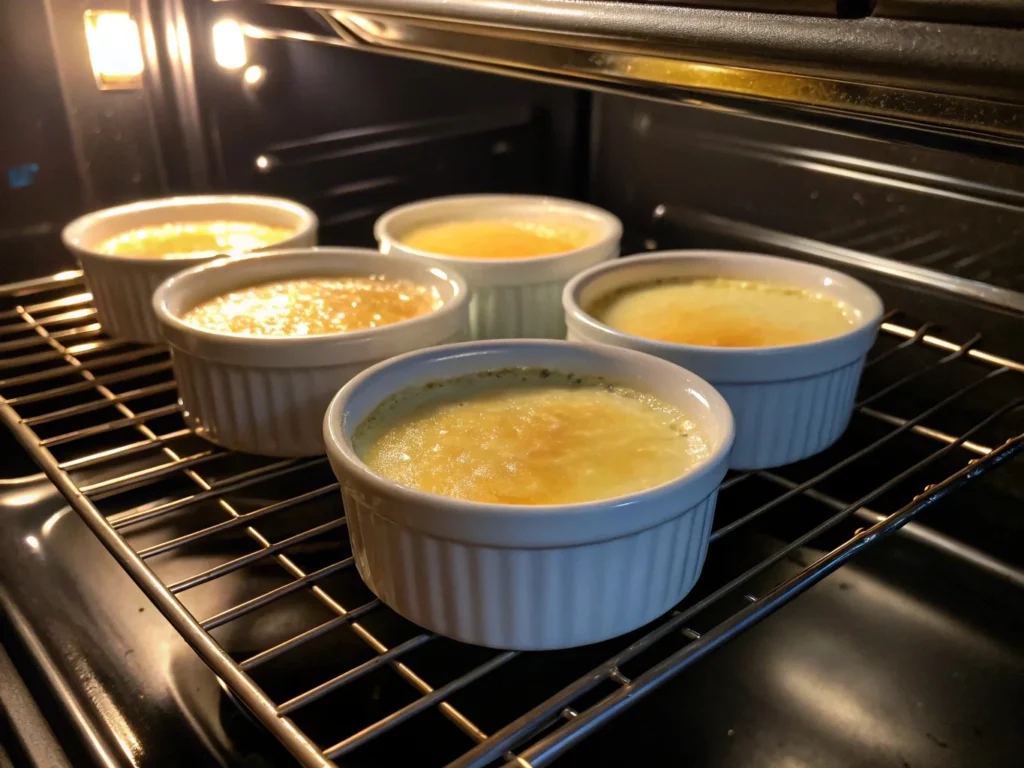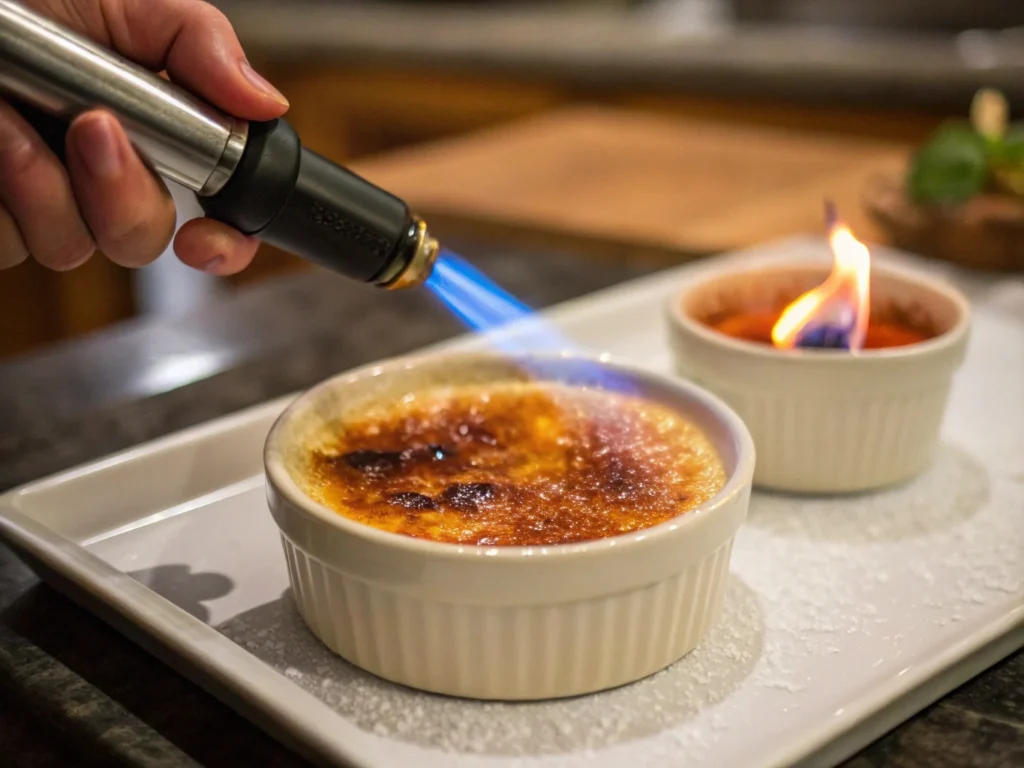The first time I cracked through the glassy caramel surface of a crème brûlée, I discovered more than just a dessert. I uncovered a culinary story. The crème brûlée definition is elegantly simple. It’s a luxurious French dessert that translates literally to “burnt cream”. This reveals exactly what makes this treat so extraordinary.
Originating in 17th-century France, this dessert embodies a magical transformation. The crème brûlée translation captures its essence perfectly. It’s a silky custard crowned with a dramatically caramelized sugar layer. This layer shatters with the gentlest tap of a spoon.

Key Takeaways
- Crème brûlée means “burnt cream” in French
- First documented recipe dates back to 1691
- Consists of rich custard with caramelized sugar topping
- Originated in French culinary tradition
- Requires precise preparation techniques
- Represents a balance of creamy and crisp textures
The Origins of the Term Crème Brûlée
Linguistic Roots of the Name
The name crème brûlée means “burnt cream” in French. It describes how the dessert is made. The first mention of it was in 1691 by François Massialot, a chef for King Louis XIV.
He wrote about it in Cuisinier royal et bourgeois.
Exploring the Word “Crème”
“Crème” comes from the Latin crema, meaning the fatty top of milk. In cooking, it’s a thick, smooth cream. For crème brûlée, it’s the base of the custard.
Understanding “Brûlée”
“Brûlée” means “to burn” in French. It describes the caramelized sugar on top. Chefs use a hot salamander or torch to make this crust.
Historical Context
Similar desserts existed in Europe before. The Spanish crema catalana and an English version appeared in the 14th century. Crème brûlée became popular in the 1980s, becoming a global favorite.

The Components of Crème Brûlée
Exploring this recipe opens up a world of flavors and textures. It’s more than just a dessert. It’s a mix of simple yet elegant ingredients that leave a lasting impression.
Cream and Sugar: The Basics
At the core of this dessert are cream and sugar. The heavy cream makes it rich and smooth, using 250 ml. Sweetened condensed milk adds 400 g of creamy goodness.
The Role of Eggs
Eggs turn cream into a creamy custard. Chefs mix three large egg yolks and two whole eggs for the right texture. The yolks are key for that creamy feel we love.
Flavor Variations
While vanilla is classic, chefs love to try new flavors. Just 2 teaspoons of vanilla bean paste can make a big difference. You can also add lavender or matcha for something unique.
| Key Ingredient | Quantity | Purpose |
|---|---|---|
| Heavy Cream | 250 ml | Creates smooth base |
| Egg Yolks | 3 large | Provides rich texture |
| Whole Eggs | 2 large | Adds structure |
| Vanilla Paste | 2 tsp | Enhances flavor |
The Cooking Process of Crème Brûlée
Making the perfect crème brûlée is all about precision and knowing its French roots. This dessert needs careful steps to turn simple ingredients into something special.
Preparing the Custard Base
Begin by picking the best ingredients. You’ll need 4 cups of heavy cream, 8 large egg yolks, and a vanilla bean or extract. Chefs say to use a 2-quart saucepan to heat the cream evenly.

The Caramelization Technique
The caramelized sugar on top is what makes the recipe stand out. Use turbinado sugar to get a crisp, golden layer. A culinary blowtorch is the best tool for this, making the sugar turn into a glassy, amber crust.
Tips for Perfecting the Texture
To get the recipe just right, pay close attention. Strain the custard through a fine mesh sieve for smoothness. Bake in a water bath at 325°F for 30-45 minutes, watching it closely. After chilling for 3 hours, caramelize the sugar with a kitchen torch right before serving.
| Key Equipment | Estimated Cost | |
|---|---|---|
| Culinary Blowtorch | $14 | |
| Ramekin Set | $19 | |
| Fine Mesh Strainer | $13 |
Pro tip: Practice makes perfect when making this French dessert. Every try will help you get better at making it.
Cultural Significance of Crème Brûlée
Crème brûlée has become a global favorite, starting as a French dessert. It literally means “burnt cream,” highlighting its caramelized top. This dessert is now seen as a sign of fine dining and luxury.
Crème Brûlée in French Cuisine
In France, crème brûlée is more than a dessert. It shows the skill of French pastry-making. The first recipe was in François Massialot’s 1691 cookbook, showing its long history in France.
Chefs in France have made it a symbol of fancy dining. They’ve perfected this dessert, making it a must-have in elegant meals.
Modern Adaptations Worldwide
Restaurants worldwide have made crème brûlée their own. They add local flavors, making it a dish for creativity. From Asian twists to American flavors, it’s a canvas for chefs.
| Region | Unique Adaptation |
|---|---|
| Spain | Crema Catalana (made with milk) |
| United States | Flavored variations like lavender and chocolate |
| Japan | Green tea-infused crème brûlée |
Popularity in American Restaurants
The 1980s were key for crème brûlée in the U.S. Sirio Maccioni said it became a hit from Paris to Peoria. The act of cracking the sugar top wowed diners, making it a favorite in restaurants.
Why It’s Called “Brûlée”
Exploring crème brûlée’s name reveals a rich culinary history. The word “brûlée” comes from French, meaning “burnt”. This perfectly describes the dessert’s caramelized top.
The Meaning of “Burnt” or “Brûlé”
In French cooking, “brûlé” is not a mistake but a skill. It’s about turning sugar into a golden, crisp layer on creamy custard. A culinary torch, costing about $30, is key to this process.
The Visual Appeal of the Topping
The caramelization makes a striking contrast. Picture a smooth custard with a glassy, amber sugar crust. When you crack it with a spoon, you hear a satisfying crackle. This is the sign of great crème brûlée.
How Caramelization Enhances Flavor
Caramelization adds more than just beauty. It brings a deep, slightly burnt sugar flavor that goes well with the custard. The broiling, which takes only 1-3 minutes, turns simple sugar into a complex topping. This enhances the dessert’s taste.

Traditional vs. Modern Recipes
Crème brûlée has changed a lot from its first appearance in François Massialot’s 1691 cookbook. Today, it’s a rich custard dessert with a caramelized sugar topping. But, modern chefs have made it their own, adding new flavors and twists.
Classic French Recipes
Traditional crème brûlée recipes are all about French pastry art. They use 20 egg yolks and 400 grams of sugar. This makes a silky custard that shows off French culinary skill. The authentic preparation demands precision, with careful attention to temperature and technique.
Creative Twists on the Dessert
Today’s chefs have made crème brûlée their own with new flavors. They add lavender, matcha, and more to the classic recipe. These new versions keep the creamy texture and caramelized top, but with a twist.
Healthier Alternatives
For those watching their diet, there are lighter versions of the dessert. These recipes use less fat, alternative sweeteners, and plant-based ingredients. They keep the dessert’s rich feel but are healthier.
| Recipe Type | Calories per Serving | Key Modifications |
|---|---|---|
| Traditional | 463 | Full-fat cream, classic method |
| Lighter Version | 250-300 | Reduced cream, alternative sweeteners |
| Vegan Option | 220-280 | Plant-based milk, coconut cream |
The Experience of Eating Crème Brûlée
Trying this elegant is a journey for your senses. It turns a simple dessert into a memorable experience. This classic treat is a mix of textures and temperatures that excites food lovers everywhere.
Textural Balance: Creamy and Crispy
The magic of crème brûlée is in its contrast. When you crack the caramelized sugar, you find smooth custard. This mix of textures makes it special.
The Role of Temperature
Temperature is key in enjoying this dessert. It’s served slightly chilled, with warm caramelized sugar on top. This mix of cool and warm creates a unique feel in your mouth.
Flavor Profiles to Explore
While vanilla is a classic, chefs now offer many flavors. You can try lavender or matcha versions. Each flavor adds a new twist to the traditional dessert.
| Flavor Profile | Unique Characteristics |
|---|---|
| Classic Vanilla | Traditional, smooth, rich custard base |
| Lavender | Floral notes, delicate aromatics |
| Matcha | Earthy green tea flavor, slight bitterness |
| Chocolate | Deep, intense cocoa undertones |
This dessert is known for its contrast of creamy custard and crisp caramelized sugar. If you’re curious about the full flavor experience, read our article on What Does Crème Brûlée Taste Like? to explore its delicate balance of sweetness and richness.
Pairing Crème Brûlée with Beverages
Finding the right drink to go with this dessert can make your meal better. This French dessert, with its creamy texture and caramelized sugar, pairs well with many drinks. It’s a treat for your taste buds.
Coffee and Tea Companions
French coffee and tea are great with crème brûlée. Espresso and French press coffee offer a nice contrast to the dessert’s light flavors.
Serving Suggestions
Serve this dessert a bit chilled. This lets the caramelized sugar on top crack nicely. Use fancy glassware or ramekins to make it look and taste even better.
Making Crème Brûlée at Home
Learning to make crème brûlée at home can change your dessert game. What does crème brûlée literally mean? It’s “burnt cream,” a French dessert with creamy custard and a caramelized top. Making it at home is simpler than you think.
Essential Kitchen Tools
To make authentic crème brûlée, you need special tools. Your kitchen should have:
| Tool | Purpose |
|---|---|
| Ramekins | Individual serving dishes for baking |
| Kitchen Torch | Caramelizing sugar topping |
| Bain-marie (Water Bath) | Ensuring even cooking of custard |
| Fine-mesh Strainer | Creating smooth custard mixture |
Step-by-Step Recipe Guide
Begin your crème brûlée journey with four main ingredients: heavy cream, egg yolks, sugar, and vanilla. The traditional mix is 2:1 cream to egg yolk. Precision is key for this delicate dessert.
First, heat the cream until it’s just below boiling, about 5-7 minutes. Mix egg yolks with sugar, then add the warm cream slowly. Strain the mix and fill ramekins. Bake in a water bath at 350°F for 40 minutes.
Common Mistakes to Avoid
Many home cooks face challenges with this recipe. Avoid overcooking the custard and keep the water bath cool. Also, chill the custards for 2-3 hours before caramelizing. About 60% of cooks use a kitchen torch for the caramelized top, which boosts success.
Pro tip: Chill your custards for 2-3 hours before caramelizing. Sprinkle about 1 teaspoon of sugar per ramekin and torch until golden. Your homemade crème brûlée will be as good as any restaurant’s!
Crème Brûlée Variations Globally
Crème brûlée’s origins go beyond France, showing a world of culinary creativity. This dessert, loved worldwide, has inspired many regional versions. Each one highlights local tastes and ingredients.
Regional Differences in Preparation
Different cultures have made their own versions of the recipe. In Spain, crema catalana is similar but with its own spice mix. Japan adds matcha and green tea, while Latin America uses coconut and passion fruit.
Unique Ingredients from Around the World
| Region | Unique Ingredient | Flavor Profile |
|---|---|---|
| Japan | Matcha Green Tea | Earthy, slightly bitter |
| Mexico | Cinnamon | Warm, spicy |
| Thailand | Coconut | Creamy, tropical |
| Italy | Espresso | Rich, intense coffee |
Fusion Dishes and Their Appeal
Today’s chefs keep making crème brûlée their own, mixing old ways with new ingredients. They’ve made versions with lavender and even savory twists. These new takes show how versatile and loved this dessert is around the world.
Crème Brûlée in Popular Media
This dessert has won over chefs, food lovers, and media makers around the world. Its rich history and unique look have made it a hit in entertainment and online.
Television and Film Spotlights
Culinary shows often use this recipe to show off pastry skills. Cooking contests push contestants to make the perfect dessert. They focus on the caramelization that makes this French treat special. Movies like *Julie & Julia* also highlight its cultural importance.
Cookbooks and Culinary Literature
Books by famous chefs like Julia Child and Thomas Keller have lots of crème brûlée recipes. These books help home cooks learn how to make it. They give detailed steps for preparing this delicate dessert.
Social Media Trends
Instagram and TikTok have made this dessert go viral. People post videos of caramelizing sugar, which gets millions of views. It inspires others to try making it at home.
| Platform | Crème Brûlée Content Type | Average Engagement |
|---|---|---|
| Video Tutorials | 50,000+ views | |
| TikTok | Caramelization Clips | 100,000+ views |
| YouTube | Professional Cooking Demos | 25,000+ views |
The digital world has turned crème brûlée into a global favorite. It has won the hearts of food lovers everywhere.
FAQs
How did crème brûlée get its name?
Crème brûlée gets its name from the French words “crème” (cream) and “brûlée” (burnt). The name directly describes the dessert’s signature caramelized sugar topping, which is torched or broiled until golden brown.
What does crème brûlée mean in French?
In French, “crème brûlée” translates to “burnt cream.” This refers to the process of caramelizing the sugar on top of the custard to create its distinct crispy layer.
What is the literal translation of brûlée?
The French word “brûlée” literally means “burnt.” It comes from the verb brûler, which means “to burn.” In culinary terms, it describes the technique of torching sugar to form a crispy, golden crust.
What came first, flan or crème brûlée?
Flan came first! Flan, known as crème caramel, dates back to ancient Rome and later became popular in Spain and France. Crème brûlée, which has a hard caramelized top, was first documented in 1691, making it a newer evolution of custard-based desserts.
What makes crème brûlée different from other custard desserts?
Unlike flan or pudding, crème brûlée is known for its contrast in texture—a smooth, creamy custard base with a hard, caramelized sugar topping. The use of a torch or broiler to create the signature “brûlée” effect sets it apart from other custards.
What is the science behind the caramelization process?
Caramelization happens when sugar is heated to 338°F (170°C). This breaks down the sugar’s molecules, changing its color and flavor. It creates a golden-brown crust and adds a complex taste.
Conclusion : The Timeless Charm of Crème Brûlée
Crème brûlée is more than just a dessert; it’s a culinary masterpiece that has captivated food lovers for centuries. From its French origins to its global variations, this luxurious treat remains a symbol of elegance and indulgence. The contrast between its silky custard and crisp caramelized topping creates a sensory experience like no other.
If you’re passionate about classic French desserts and want to explore more about the ingredients used in crème brûlée, check out our detailed guide on Milk vs. Heavy Cream in Crème Brûlée. This article will help you understand how different dairy choices can affect the texture and flavor of your crème brûlée.
Whether you enjoy it in its traditional vanilla form or experiment with modern flavors, crème brûlée continues to be a timeless delight that never goes out of style. So next time you crack into that caramelized sugar topping, take a moment to appreciate the rich history and artistry behind this iconic dessert. Bon appétit!
